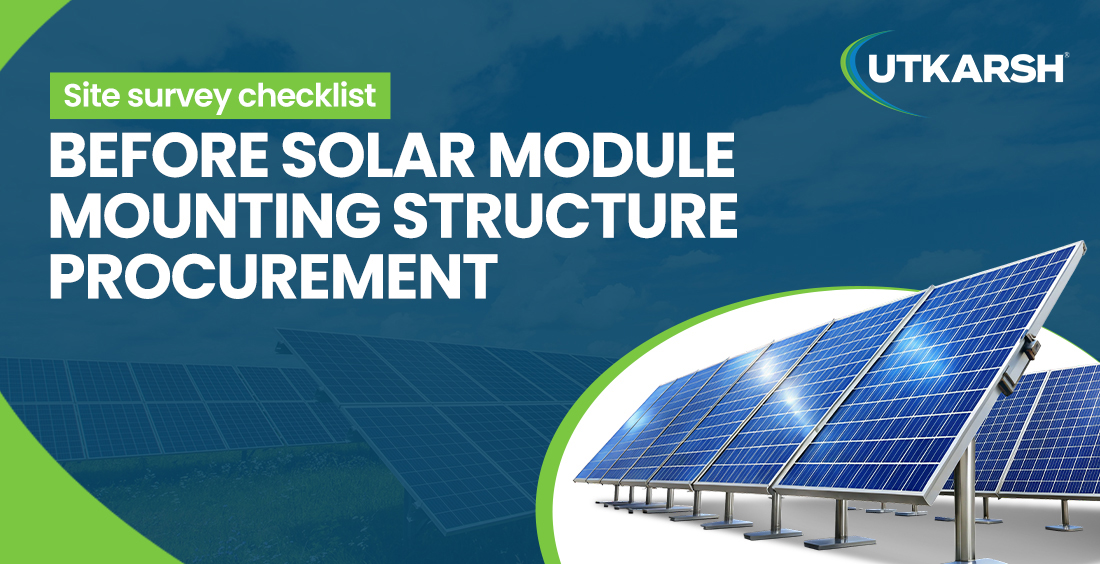Site Survey Checklist Before Solar Module Mounting Structure Procurement

Quick Overview
A site survey is the foundation of a successful project. Before beginning solar module mounting structure procurement, a thorough checklist should be followed to ensure accuracy in terms of design and performance. This survey helps in analyzing soil condition, wind load, and the safety of the structure.
This blog outlines how a site survey checklist guides solar project owners and contractors, EPC companies, and project developers before procuring the right solar mounting structure.
Importance of Site Survey in Solar Projects
The long-term success depends on the structure, but the longevity of the structure depends on the insight of the survey provided by data, which helps the engineers and project developers to understand the condition of the soil and wind at that exact location.
Skipping this process may lead to structural failure, miscellaneous costs on repair, replacement, and complications issues. Henceforth, solar module mounting structure procurement should be counted among the basic practices by field engineers.
Key Parameters in a Site Survey
1. Soil Testing and Ground Condition
- Geotechnical analysis helps to evaluate soil type, density, and bearing capacity.
- It helps to identify whether the soil needs a raft or a ballast foundation for a solar structure.
- Ensure that the soil is compatible with anti-corrosion treatment
2. Topography and Layout
- Evaluate the flatness, gradient, and slope of the land
- Specify the exact location of which will help to get more exposure and good stability of the structure.
- Identify the shaded regions to prevent from energy loss
3. Environmental and Climate Factors
- Assist the temperature and humidity fluctuation
- Check the coastal condition of that area because that demands corrosion-resistant solar module mounting structures.
- Design the structure while calculating the dust, rainfall, and wind
4. Wind and Snow Load Analysis
- Calculate the peak and average wind speed for the structural design compliance
- Analyse the snow load (for hilly areas) to prevent from excessive stress
- Ensure the structure meets the global and local standards
5. Logistic Support and Accessibility
- Ensure the site has enough space for the movement of heavy solar design equipment
- The transportation of the plate should be done carefully and without delay
- Confirm the availability of the crane and other safety equipment at the time of installation
6. Approvals and Compliance
- Take the consent from the landowner and local government bodies
- Ensure the guidelines of the state and national renewable energy guidelines
- Implement every safety protocol mentioned in the code of the solar structure
Manufacturer’s Quality Checklist for Solar Mounting Structure
While a site survey provides the critical data, the true strength lies in the quality of its solar module mounting structure. Therefore, partnering with a manufacturer who can deliver precisely engineered products with strict testing and certified standards is the main path to walk on. To ensure reliability and long-term performance, a trusted manufacturer must meet the following checklist:
- Precision Engineering: Every structure should be designed with exact dimension accuracy to handle the site-specific load requirements.
- Corrosion Resistance: A protection of hot-dip galvanized iron coating must be applied to safeguard against rust and rainfall.
- Rigorous Testing: Every component undergoes rigorous testing to validate the performance and lifespan of the solar structure.
- Certified Standards: Compliance with IS, IEC, and ASTM standards ensures global-level quality and benchmarks.
- Adaptability: Structure must be customisable for varied terrains, whether flatland, slopes, or coastal zones.
Utkarsh India Advantages in Solar Module Structure
At Utkarsh India Limited, quality is engineered into every product. State-of-the-art facilities are equipped with an advanced galvanised process. Each component of the product undergoes multiple levels of inspection to ensure consistency and zero defects.
We strictly adhere to local, national, and global protocols, which leverage every project and give confidence to the developer or project executer to withstand windload, seismic activity, and corrosive environments. As they are thoroughly aligned with renewal energy standards and guidelines, they guarantee not a product but a constant idea of innovation and sustainability with the goal of a zero carbon footprint in India.
Final Words
A successful solar project depends on the right solar module mounting structure, which becomes accurate with the help of a site survey. On the same ground, the quality of the solar mount panel equally plays an important role in making a successful project. This quality check for a solar mounting structure helps a layman get more aware and oriented towards renewable energy and kick a step ahead towards a zero-carbon environment in India.